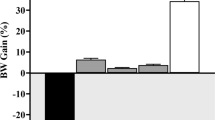Abstract
This study analyzed the content of phenolic acids and flavonoids in extracts of guava fruit (Psidium guajava L.), and examined the renal protective effects of guava aqueous extract (GAE) and ethanol extract (GEE) in diabetic mice. GAE had more caffeic acid, myricetin, and quercetin; and GEE had more cinnamic, coumaric and ferulic acids. GAE or GEE at 1 and 2 % was supplied in diet for 12 weeks. GAE or GEE intake at 2 % significantly reduced glucose and blood urea nitrogen levels, increased insulin level in plasma of diabetic mice (p < 0.05). GAE or GEE treatments dose-dependently reserved glutathione content, retained activity of catalase and glutathione peroxidase, and decreased reactive oxygen species, interleukin (IL)-6, tumor necrosis factor-α and IL-1β levels in kidney (p < 0.05). GAE and GEE treatments at 2 % significantly declined renal N ε-(carboxymethyl)lysine, pentosidine and fructose levels (p < 0.05), and suppressed renal activity of aldose reductase (p < 0.05). These findings support that guava fruit could protect kidney against diabetic progression via its anti-oxidative, anti-inflammatory and anti-glycative effects.
Similar content being viewed by others
Abbreviations
- AGE:
-
Advanced glycation endproduct
- AR:
-
Aldose reductase
- CML:
-
N ε-(carboxymethyl)lysine
- Cr:
-
Creatinine
- IL-6:
-
Interleukin-6
- GPX:
-
Glutathione peroxidase
- GSSG:
-
Oxidized glutathione
- ROS:
-
Reactive oxygen species
- SOD:
-
Superoxide dismutase
- TNF-α:
-
Tumor necrosis factor-α
References
Jawaheer B, Goburdhun D, Ruggoo A (2003) Effect of processing and storage of guava into jam and juice on the ascorbic acid content. Plant Foods Hum Nutr 58:1–12
Mahattanatawee K, Manthey JA, Luzio G, Talcott ST, Goodner K, Baldwin EA (2006) Total antioxidant activity and fiber content of select Florida-grown tropical fruits. J Agric Food Chem 54:7355–7363
Soman S, Rauf AA, Indira M, Rajamanickam C (2010) Antioxidant and antiglycative potential of ethyl acetate fraction of Psidium guajava leaf extract in streptozotocin-induced diabetic rats. Plant Foods Hum Nutr 65:386–391
Shen SC, Cheng FC, Wu NJ (2008) Effect of guava (Psidium guajava Linn.) leaf soluble solids on glucose metabolism in type 2 diabetic rats. Phytother Res 22:1458–1464
Huang CS, Yin MC, Chiu LC (2011) Antihyperglycemic and antioxidative potential of Psidium guajava fruit in streptozotocin-induced diabetic rats. Food Chem Toxicol 49:2189–2195
Shah IM, Mackay SP, McKay GA (2009) Therapeutic strategies in the treatment of diabetic nephropathy - A translational medicine approach. Curr Med Chem 16:997–1016
Graves DT, Kayal RA (2008) Diabetic complications and dysregulated innate immunity. Front Biosci 13:1227–1239
Navarro-González JF, Mora-Fernández C (2008) The role of inflammatory cytokines in diabetic nephropathy. J Am Soc Nephrol 19:433–442
Sato T, Iwaki M, Shimogaito N, Wu X, Yamagishi S, Takeuchi M (2006) TAGE (toxic AGEs) theory in diabetic complications. Curr Mol Med 6:351–358
Lin CY, Tsai SJ, Huang CS, Yin MC (2011) Antiglycative effects of protocatechuic acid in the kidneys of diabetic mice. J Agric Food Chem 59:5117–5124
Zapata S, Dufour JP (1992) Ascorbic, dehydroascorbic and isoascorbic acid simultaneous determinations by reverse phase ion interaction HPLC. J Food Sci 57:506–511
Sreelatha S, Padma PR (2009) Antioxidant activity and total phenolic content of Moringa oleifera leaves in two stages of maturity. Plant Foods Hum Nutr 64:303–311
Sellappan S, Akoh CC, Krewer G (2002) Phenolic compounds and antioxidant capacity of Georgia-grown blueberries and blackberries. J Agric Food Chem 50:2432–2438
Schaffer AA, Aloni B, Fogelman E (1987) Sucrose metabolism and accumulation in developing fruit of Cucumis. Phytochemistry 26:1883–1887
Lowry OH, Rosebrough NJ, Farr AL (1951) Protein determination with the Folin phenol reagent. J Biol Chem 193:265–275
Hsu CC, Lin CC, Liao TS, Yin MC (2006) Protective effect of s-allyl cysteine and spropyl cysteine on acetaminophen-induced hepatotoxicity in mice. Food Chem Toxicol 44:393–397
Chao CY, Mong MC, Chan KC, Yin MC (2010) Anti-glycative and anti-inflammatory effects of caffeic acid and ellagic acid in kidney of diabetic mice. Mol Nutr Food Res 54:388–395
Nishinaka T, Yabe-Nishimura C (2001) EGF receptor-ERK pathway is the major signaling pathway that mediates upregulation of aldose reductase expression under oxidative stress. Free Radic Biol Med 31:205–216
Jain N, Dhawan K, Malhotra S, Singh R (2003) Biochemistry of fruit ripening of guava (Psidium guajava L.): Compositional and enzymatic changes. Plant Foods Hum Nutr 58:309–315
Dixit Y, Kar A (2010) Protective role of three vegetable peels in alloxan induced diabetes mellitus in male mice. Plant Foods Hum Nutr 65:284–289
Jung EH, Kim SR, Hwang IK, Ha TY (2007) Hypoglycemic effects of a phenolic acid fraction of rice bran and ferulic acid in C57BL/KsJ-db/db mice. J Agric Food Chem 55:9800–9804
Busik JV, Mohr S, Grant MB (2008) Hyperglycemia-induced reactive oxygen species toxicity to endothelial cells is dependent on paracrine mediators. Diabetes 57:1952–1965
Tsai SJ, Huang CS, Mong MC, Kam WY, Huang HY, Yin MC (2012) Anti-inflammatory and antifibrotic effects of naringenin in diabetic mice. J Agric Food Chem 60:514–521
Koukoulitsa C, Zika C, Geromichalos GD, Demopoulos VJ, Skaltsa H (2006) Evaluation of aldose reductase inhibition and docking studies of some secondary metabolites, isolated from Origanum vulgare L. ssp. hirtum. Bioorg Med Chem 14:1653–1659
Urios P, Grigorova-Borsos AM, Sternberg M (2007) Flavonoids inhibit the formation of the cross-linking AGE pentosidine in collagen incubated with glucose, according to their structure. Eur J Nutr 46:139–146
Acknowledgments
This study was supported by a grant from China Medical University, Taichung City, Taiwan (CMU100-ASIA-01).
Conflict of interest
The authors declare that they have no conflict of interest.
Author information
Authors and Affiliations
Corresponding author
Rights and permissions
About this article
Cite this article
Lin, CY., Yin, MC. Renal Protective Effects of Extracts from Guava Fruit (Psidium guajava L.) in Diabetic Mice. Plant Foods Hum Nutr 67, 303–308 (2012). https://doi.org/10.1007/s11130-012-0294-0
Published:
Issue Date:
DOI: https://doi.org/10.1007/s11130-012-0294-0




